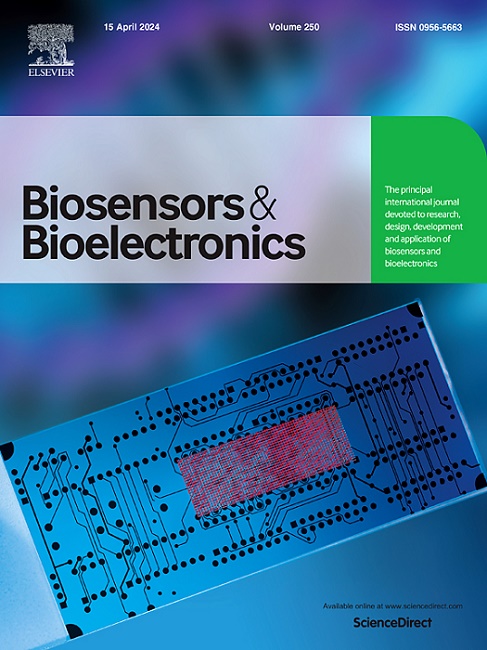A label-free optical biosensor-based point-of-care test for the rapid detection of Monkeypox virus
IF 10.7
1区 生物学
Q1 BIOPHYSICS
引用次数: 0
Abstract
Diagnostic approaches that combine the high sensitivity and specificity of laboratory-based digital detection with the ease of use and affordability of point-of-care (POC) technologies could revolutionize disease diagnostics. This is especially true in infectious disease diagnostics, where rapid and accurate pathogen detection is critical to curbing the spread of disease. We have pioneered an innovative label-free digital detection platform that utilizes Interferometric Reflectance Imaging Sensor (IRIS) technology. IRIS leverages light interference from an optically transparent thin film, eliminating the need for complex optical resonances to enhance the signal by harnessing light interference and the power of signal averaging in shot-noise-limited operation In our latest work, we have further improved our previous 'Single-Particle' IRIS (SP-IRIS) technology by allowing the construction of the optical signature of target nanoparticles (whole virus) from a single image. This new platform, 'Pixel-Diversity' IRIS (PD-IRIS), eliminated the need for z-scan acquisition, required in SP-IRIS, a time-consuming and expensive process, and made our technology more applicable to POC settings. Using PD-IRIS, we quantitatively detected the Monkeypox virus (MPXV), the etiological agent for Monkeypox (Mpox) infection. MPXV was captured by anti-A29 monoclonal antibody (mAb 69-126-3) on Protein G spots on the sensor chips and were detected at a limit-of-detection (LOD) - of 200 PFU/mL (∼3.3 aM). PD-IRIS was superior to the laboratory-based ELISA (LOD - 1800 PFU/mL) used as a comparator. The specificity of PD-IRIS in MPXV detection was demonstrated using Herpes simplex virus, type 1 (HSV-1), and Cowpox virus (CPXV). This work establishes the effectiveness of PD-IRIS and opens possibilities for its advancement in clinical diagnostics of Mpox at POC. Moreover, PD-IRIS is a modular technology that can be adapted for the multiplex detection of pathogens for which high-affinity ligands are available that can bind their surface antigens to capture them on the sensor surface.
用于快速检测猴痘病毒的无标记光学生物传感器床旁检验。
将基于实验室的数字检测的高灵敏度和特异性与使用方便、经济实惠的护理点(POC)技术相结合的诊断方法,将为疾病诊断带来一场革命。在传染病诊断领域尤其如此,因为快速准确的病原体检测对于遏制疾病的传播至关重要。我们利用干涉反射成像传感器(IRIS)技术开创了一种创新的无标记数字检测平台。IRIS 利用来自光学透明薄膜的光干扰,无需复杂的光学共振,通过利用光干扰和信号平均的力量在镜头噪声受限操作中增强信号。这一新平台,即 "像素多样性 "红外成像系统(PD-IRIS),省去了 SP-IRIS 所需的 Z 扫描采集这一耗时且昂贵的过程,使我们的技术更适用于 POC 环境。利用 PD-IRIS,我们定量检测了猴痘病毒(MPXV),这是猴痘(Mpox)感染的病原体。MPXV被抗A29单克隆抗体(mAb 69-126-3)捕获在传感器芯片上的蛋白质G点上,检测限(LOD)为200 PFU/mL(∼3.3 aM)。PD-IRIS 优于作为参照物的实验室 ELISA(LOD - 1800 PFU/mL)。使用 1 型单纯疱疹病毒(HSV-1)和牛痘病毒(CPXV)证明了 PD-IRIS 检测 MPXV 的特异性。这项工作证明了 PD-IRIS 的有效性,并为其在 POC 的痘痘临床诊断中的应用提供了可能性。此外,PD-IRIS 是一种模块化技术,可适用于病原体的多重检测,这些病原体的高亲和性配体可与其表面抗原结合,将其捕获到传感器表面。
本文章由计算机程序翻译,如有差异,请以英文原文为准。
求助全文
约1分钟内获得全文
求助全文
来源期刊

Biosensors and Bioelectronics
工程技术-电化学
CiteScore
20.80
自引率
7.10%
发文量
1006
审稿时长
29 days
期刊介绍:
Biosensors & Bioelectronics, along with its open access companion journal Biosensors & Bioelectronics: X, is the leading international publication in the field of biosensors and bioelectronics. It covers research, design, development, and application of biosensors, which are analytical devices incorporating biological materials with physicochemical transducers. These devices, including sensors, DNA chips, electronic noses, and lab-on-a-chip, produce digital signals proportional to specific analytes. Examples include immunosensors and enzyme-based biosensors, applied in various fields such as medicine, environmental monitoring, and food industry. The journal also focuses on molecular and supramolecular structures for enhancing device performance.
 求助内容:
求助内容: 应助结果提醒方式:
应助结果提醒方式:


